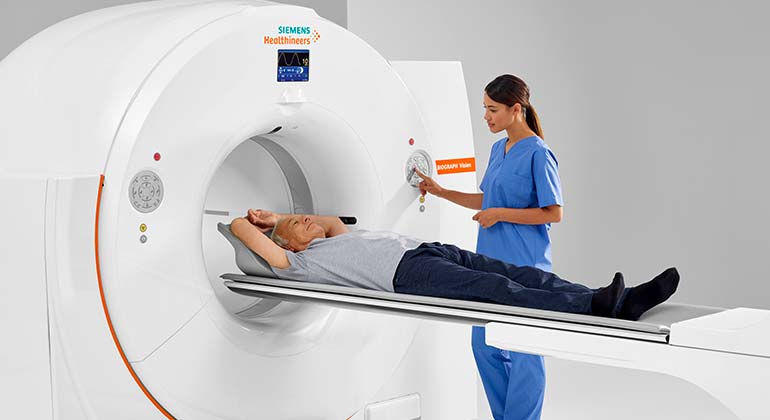Nuclear Medicine


Nuclear medicine uses radioactive substances for diagnosis and treatment of various conditions. We call these substances radiopharmaceuticals or radiotracers. Depending on the exam, you inject, inhale, or swallow the radiotracer, which gives off radiation in the form of gamma rays. We use a special camera to create images of the area we are studying. The camera does not emit any radiation. At Mount Sinai, we have extensive expertise in the latest techniques and approaches in nuclear medicine.
Most people do not experience acute or long-term side effects or allergic reactions from nuclear medicine. You may be a little uncomfortable, though, because you must remain still during the imaging process. If you tend to feel uncomfortable in small spaces, tell your technologist before the exam.
Diagnostic Studies
Nuclear medicine helps us diagnose conditions without surgery. Many diagnostic procedures we do at Mount Sinai use positron emission testing (PET) scans, which are painless. We often use PET scans in combination with either computed tomography (CT) or fluorodeoxyglucose (FDG) scans.
Nuclear medicine tests can also assess your cardiovascular system, central nervous system, endocrines, gastrointestinal tract, genitourinary, musculoskeletal structure, and respiratory system, among others.
Radioactive tracers are chemical compounds that enable imaging technologies such as positron emission tomography and gamma cameras to see how your body is functioning. Tracers help us diagnose and treat illness. Recent research has developed a number of tracers that are particularly effective for specific conditions. For instance, Axumin helps us diagnose prostate cancer; NetSpot is useful with pinpointing neuroendocrine tumors; and sodium fluoride enables us to identify cancers of the bone and cancers that have spread (metastasized) to the bone. In addition, we use three types of tracers to diagnose Alzheimer’s disease: Neuroaceq, Amyvid, and Vizamyl.
Radiotherapy Treatments
Mount Sinai Nuclear Medicine uses radiotherapy treatments to destroy cancer cells and shrink tumors. We administer radiotherapy by inserting radioactive material directly into your body. At Mount Sinai, we use these types of radiotherapy treatments:
- Lu 177-dotatate therapy (Lutathera) treats neuroendocrine tumors that have spread (metastasized). This drug is given intravenously to deliver radiation directly into the cancer cells. If we use this treatment, you should be very careful to follow the instructions your doctor gives you about limiting the exposure of people around you. In general, we ask you to avoid close contact with people. Try to keep at least three feet away from people for two to three days after the treatment.
- Iodine-131 (I-131) helps treat hyperthyroidism and thyroid cancer. Studies have shown that this medication improves the survival rate. We inject it intravenously to destroy tumor tissues. We may combine it with other medications to help it target specific cancer cells. Your body will expel most of the radioiodine during the first week after treatment, though some may remain for up to three months. We will give you special instructions about how to protect yourself and others from radiation exposure.
- Ibritumomab Tiuxetan (also called Zevalin Y-90) helps us treat non-Hodgkin’s lymphoma. We usually use it with a drug called rituximab. Ibritumomab tiuxetan targets white blood cells, delivering radiation directly to the tumor. While you are on this medication, you may bleed more easily. You may also have a greater chance of infection. Since the drug is radioactive, we will provide specific instructions to limit exposure for you and other people. Talk with your doctor about any side effects; we may be able to help with them.